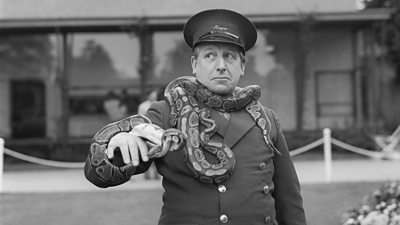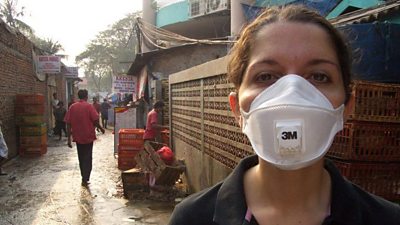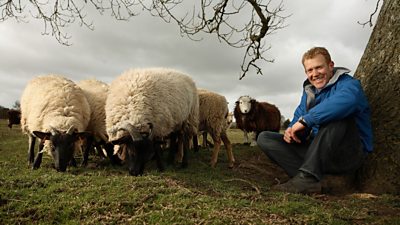This Guide mainly applies to small animals. The animals may be wild or domesticated, including mammals, reptiles, insects, amphibians, fish, etc.
The Guide does not apply to the filming of animals in the wild, nor to animals involved in sporting events e.g. greyhound racing, horse riding, etc., nor to the filming of larger animals found in zoos, farms or animal sanctuaries (see our Guideline in Related Topics).
What Can Go Wrong?
- Attack by animal - bite, scratch, sting
- Infection / allergic reaction - through bite, contact, or ingestion / inhalation of animal material
- Stress / anxiety of persons – caused by phobias, threat of bite / sting
- Stress to animal – unfamiliar location, inadequate welfare provision, poorly handled, unusual stimuli.
Legal/91�ȱ� Requirements
- The Dangerous Wild Animals Act 1976 (DWA) governs the issue of licenses by local authorities to those who wish to keep, handle, display and transport animals which come under the Act (listed in its Schedule)
- The Animal Welfare Act 2006 places a duty of care on owners and handlers of animals to protect all aspects of their health and welfare
- The Animal Welfare (Licensing of Activities Involving Animals) (England) Regulations 2018 places a duty for animals involved in a 'performance' to be licensed.
Control Measures
Planning the performance
- Select the animal type – this may already be defined by the storyline, but if not, and before you engage it, make sure that any venue where the animal will be displayed or perform is able and willing to accommodate it and that you can meet all of the relevant requirements listed in this Guide.
- Engage an expert – for small domesticated animals not being asked to do anything out of the ordinary for them, this could simply be the animal’s owner. For a simple display (e.g. an exotic animal kept within a tank or cage), the expert handler could be a licensed pet shop owner. For all other situations however, you will need to engage a licensed animal handler - this licence is issued by the Local Authority and will state the type and number of animals the handler is permitted to handle. Obtain a copy of the licence and check it is valid and in date. Also check that they have appropriate professional indemnity insurance in case the animal was to cause harm to anyone. Once engaged, it is the handler’s responsibility to provide an animal which is both fit and well, disease-free and of a temperament or properly contained / restrained as to be able to provide a safe performance
- DWA Licencing – if the animal required is listed within the DWA, ensure that the handler has a DWA licence with appropriate conditions i.e. to keep, display and transport the animals in question as needed. Obtain a copy of the licence and check it is in date and applies to the handler and their premises. Also, check that they have appropriate professional indemnity insurance in case the animal were to cause harm to anyone.
- Scope the activity – discuss with the expert your requirements from the animal. Will it be handled by a presenter, by children? Does the person handling it have an acute phobia which may cause them not to follow the handler’s instructions? Is there a need for a familiarisation period with the animal before it can be handled safely? Is there anything about the venue which gives cause for concern e.g. access limitations, distance of travel requiring an overnight for the handler and their animal?
- Risk assessment – obtain a risk assessment from the handler. It should describe the following: risks the animal poses to others, welfare requirements for the animal, containment required, first aid arrangements required in event of bite / sting, personal protective equipment required, how it may be safely filmed (for example, this may include shooting through a screen to protect the camera operator). Check that no-one in the team who may handle it has an allergy to the animal or its venom.
- Animal welfare – the scoping of the activity and the handler’s risk assessment should help define the measures needed to safeguard the welfare of the animal. This will include such factors as: the air temperature, presence of unusual stimuli for the animal such as bright lights and loud noises, the time it is on display or handled, and access to food / water.
Managing the performance on the day
- Safety brief – this should be given by the handler prior to the animal being displayed or handled. It should cover all of the key points of the risk assessment. Ensure the production team and, if necessary, any audience or members of the public who are present, are advised on what they should and should not do to prevent stressing or alarming the animal, including avoidance of loud noises, bright lights or sudden movements.
- Safety provision – check that all the requirements of the risk assessment are in place, including first aid arrangements, personal protective equipment, containment arrangements, welfare arrangements, etc.
- The performance – the behaviour of some animals can be unpredictable in nature, especially in environments which are unusual to them. The handler must be present at all times when the animal is performing or being displayed and able to monitor the animal’s behaviour. If they have cause for concern, it is their responsibility to either stop the performance or make such changes as are necessary to safeguard the animal and those handling it. Try to minimise the time the animal is required to be handled or displayed.
- Hygiene standards – where contact with the animal or its’ droppings / urine presents risks associated with viral or bacterial infection, ensure all crew observe strict hygiene practices before eating, drinking or smoking i.e. thoroughly washing skin surfaces with antibacterial soaps / gels. Also, any droppings / urine or other material associated with the animal must be thoroughly cleaned up.
- Accidents – the unpredictable nature of some animals mean that they can get spooked or feel threatened and strike out. Ensure adequate first aid arrangements are in place - for some particularly venomous animals, this may mean knowing which hospital a casualty should be taken to for specialised anti-venom treatment, or arranging for this treatment option to be available at a more local hospital. Allow minor bites or scratches to bleed, then wash with clean water and dress the wound. If serious seek medical attention, which may include the need for a tetanus injection.
- Animal escape – you must know what to do if the animal escapes. If the animal is particularly dangerous, this may include evacuating the venue (without causing panic) and/or notifying the police.
Division Specific Issues
- No division specific issues.
FAQs/Did You Know?
- The RSPCA have provided a comprehensive guide to working with animals in productions (see Recommended Links), though you will need to register with them (free) to be able to download a copy
- The handler’s will typically be your best source of advice on the risks posed by the animal. It can sometimes happen though that their familiarity with the animal can result in them underestimating the risk it poses to others, especially those who may be nervous and through their fear be unable to follow simple instructions.
Useful Documents
Recommended links
-
Includes the schedule of animals requiring licencing under the Act
-
Schedule 7 - keeping or training animals for exhibition
-
Download their extensive guidelines to animal welfare on productions
-
RSPCA's FAQ to working with animals on productions
-
BHS safety work
-
Rider and Product Safety
-
Information on the diagnosis and management of diseases which can pass from animals to humans
-
NHS advice on risks and precautions for the disease
-
List of notifiable diseases in animals and how to report them
Animal topics
-

Animals: Displaying and handling for performance
A guide to the display of animals during TV, radio or other production performances e.g. live event. -

Bees: Working with
Safety measures when working with bees -

Disease and Contact with Viruses and Bacteria
Guide on infectious disease from human, animal, insect or parasite sources. -

Farms, Zoos and Animal Sanctuaries
Guidance on working with 'captive' animals.
More from SSR
-
Your platform to record accidents, risk assessments, assurance monitoring and inspections
-
Safety Equipment Stores
Just one number to call: 020 3614 5155 -
91�ȱ� Safety Guidelines
An A-Z of 91�ȱ�'s Health and Safety Guidelines -
Safety Advice Line: 0370 411 0464 Email: safety@bbc.co.uk
Events guidance - key links:
- Exhibitions
- General Guidance
- Indoor Location Recce Checklist
- Outdoor Location Recce Checklist
- Major Incidents & Emergency Planning
- Marketing and Promotional
- Noise Exposure
- Planning and Management
- Responsibilities
- Responsibilities Form
- Laser Lighting Effects
- Strobe Lighting
- Temporary Stages and Rostra
Health topics - key links:
- (91�ȱ� network only)
- Contributors Fitness to Participate
- Display Screen Equipment (DSE)
- (91�ȱ� network only)
- First Aid and Welfare on Location
- International Travel - Risks & Health
- Manual Handling
- Mental Health: 91�ȱ�page
- (91�ȱ� network only)
- Personal Health and Wellbeing
- Pregnancy
- Psychological Trauma Support & Trauma Risk Management (TRiM)
- Tiredness and Fatigue
- Travel Health Contacts
91�ȱ� High Risk - key links:
- CBRN and Industrial Spills
- Covert Filming
- Crisis Management and Security Support
- Demonstrations, Protests and Crowds
- Disaster Coverage
- Door Stepping
- (91�ȱ� network only)
- (91�ȱ� network only)
- Public Order
- Safety Equipment Stores
91�ȱ� Journalism - key links:
91�ȱ� Productions - key links:
- Aerial Filming and Airfields
- Animals: Displaying and handling for performance
- Boats: Working on
- Children and Young People
- Driving
- Electrical Equipment and Systems
- First Aid and Welfare on Location
- Food Safety (Cooking and Catering)
- Remote Location Working
- Roads and Streets: Working by
- Security of Productions on Location
- Stunts
- Tiredness and Fatigue
- Unmanned Aerial Systems (UAS aka Drones)
- Vehicles: Recording in, from and around
- Working at Height: Mobile Elevating Work Platforms
- Working at Height: Tower Scaffolds
91�ȱ� Radio - key links:
- (91�ȱ� Network only)
91�ȱ� Security - key links:
91�ȱ� Sport - key links:
About this site
This site describes what the 91�ȱ� does in relation to managing its health, safety and security risks and is intended for those who work directly for the 91�ȱ�.
It is not intended to provide instruction or guidance on how third parties should manage their risks. The 91�ȱ� cannot be held liable for how this information is interpreted or used by third parties, nor provide any assurance that adopting it would provide any measure of legal compliance. More information
Some links on this site are only accessible when connected to the 91�ȱ� network
